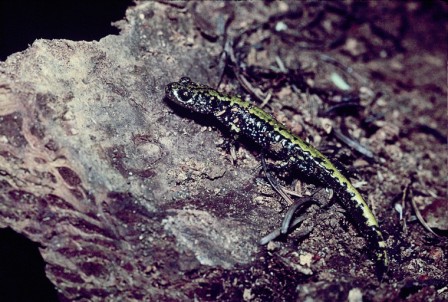
BC Conservation Data Centre: Conservation Status Report
Ambystoma macrodactylum
Long-toed Salamander

| Scientific Name: | Ambystoma macrodactylum |
|---|---|
| English Name: | Long-toed Salamander |
| Provincial Status Summary | |
| Status: | S5 |
| Date Status Assigned: | October 11, 2023 |
| Date Last Reviewed: | October 11, 2023 |
| Reasons: | This species occurs throughout BC (except Haida Gwaii). Roads, logging, and shifting habitats as a result of climate change threats are threats but are considered low. |
| Range | |
| Range Extent: | G = 200,000-2,500,000 square km |
| Range Extent Estimate (km2): | 670,000 |
| Range Extent Comments: | Ambystoma macrodactylum is distributed throughout British Columbia from the US border north to the Peace River in the east and the Taku River in the west, including southeast Vancouver Island, but not Haida Gwaii (COSEWIC 2005k; Matsuda et al. 2006, iNaturalist; Accessed 20-February-2022). Populations range from sea level to 2400m in elevation (Matsuda et al. 2006). No recent expansions or contractions in the salamander's Canadian distribution are evident (COSEWIC 2005k). |
| Area of Occupancy (km2): | G = 501-2,500 |
| Area of Occupancy Comments: | A minimum of 1392 4km2 grids based only on iNaturalist records (accessed 20-February-2022). |
| Occurrences & Population | |
| Number of Occurrences: | E = > 300 |
| Comments: | Over 1,300 long-toed salamander locations have been identified within Canada, most of which are in BC (COSEWIC 2005k). These locations translate to many fewer element occurrences, however there will be over 300 (Matsuda et al. 2006). |
| Number of Occurrences with Good Viability / Ecological Integrity: | U = Unknown |
| Number of Occurrences Appropriately Protected & Managed: | Rank Factor not assessed |
| Population Size: | F = 10,000 - 100,000 individuals |
| Comments: | Total adult population size is unknown but surely exceeds 10,000. |
| Threats (to population, occurrences, or area affected) | |
| Degree of Threat: | D = Low |
| Comments: | A threats assessment was completed in September of 2023 resulting in a score of low. "Roads, logging, and shifting habitats as a result of climate change (i.e., degradation and loss of wetland habitats) were identified as primary threats for this species. Although the species' range overlaps with the geographic area of the province that has extensive land use for agriculture and forestry, a variety of non-native vertebrates predators in aquatic habitats, and experiences relatively high development pressure, it is a generalist species that occurs in and exploits a variety of habitat types and elevations and is adaptable to habitat change". |
| Trend (in population, range, area occupied, and/or condition of occurrences) | |
| Short-Term Trend: | U = Unknown |
| Long-Term Trend: | U = Unknown |
| Other Factors | |
| Intrinsic Vulnerability: | C=Not intrinsically vulnerable |
| Comments: | Long-toed Salamanders reach maturity in 2-3 years. The female lays up to 60 eggs which hatch in two to three weeks. Usually larvae metamorphose that same summer except at high elevations where they may overwinter and transform the following summer (Matsuda et al. 2006). |
| Environmental Specificity: | CD = Moderate to broad. |
| Comments: | Long-toed salamanders are habitat generalists inhabiting a variety of terrestrial and aquatic habitats. However, their habitat needs are complex and it is essential that suitable terrestrial and aquatic habitats be located adjacent to one another. During the terrestrial stage appropriate temperatures and adequate moisture levels are required as well as existing interstitial spaces such as rodent burrows and natural cavities, as this species is not capable of burrowing (COSEWIC 2005k). |
| Other Rank Considerations: | |
| Information Gaps | |
| Research Needs: | |
| Inventory Needs: | |
| Stewardship | |
| Protection: | This species would benefit from protection of habitat near breeding ponds. Prohibit introductions of non-native fishes in salamander habitat. |
| Management: | |
| Version | |
| Author: | L. Gelling and L. Ramsay |
| Date: | February 20, 2022 |
| References | |
|
Adams, M.J., B.R. Hossack, R.A. Knapp, et al. 2005. Distribution patterns of lentic-breeding amphibians in relation to ultraviolet radiation exposure in western North America. Ecosystems 8:488-500.
|
|
|
COSEWIC 2005k. Draft COSEWIC status report on Long-toed Salamander Ambystoma macrodactylum in Canada. Comm. on the Status of Endangered Wildl. in Can. Ottawa. iv + 34pp.
|
|
|
Funk, W. C., and W. W. Dunlap. 1999. Colonization of high-elevation lakes by long-toed salamanders (Ambystoma macrodactylum) after the extinction of introduced trout populations. Canadian Journal of Zoology 77:1759-1767.
|
|
|
Kenison, E., A.R. Litt, A.S.Pilliod, et al. 2016. Role of habitat complexity in predator?prey dynamics between an introduced fish and larval Long-toed Salamanders (Ambystoma macrodactylum). Canadian Journal of Zoology 94(4): 243-249.
|
|
|
Martel et al. 2013. Batrachochytrium salamandrivorans sp. nov. causes lethal chytridiomycosis in amphibians. PNAS Sep 17; 110(38): 15325?15329
|
|
|
Matsuda, B.M., D.M. Green and P.T. Gregory. 2006. Royal BC Museum handbook amphibians and reptiles of British Columbia. Royal B.C. Mus., Victoria, BC. 266pp.
|
|
|
Tyler, T., W.J. Liss, L.M. Ganio, G.L. Larson, R. Hoffman, E. Deimling, and G. Lomnicky. 1998a. Interaction between introduced trout and larval salamanders (Ambystoma macrodactylum) in high-elevation lakes. Conservation Biology 12:94-105.
|
|
Please visit the website Conservation Status Ranks for information on how the CDC determines conservation status ranks. For global conservation status reports and ranks, please visit the NatureServe website http://www.natureserve.org/.
Suggested Citation:
B.C. Conservation Data Centre. 2022. Conservation Status Report: Ambystoma macrodactylum. B.C. Minist. of Environment. Available: https://a100.gov.bc.ca/pub/eswp/ (accessed Jun 29, 2025).